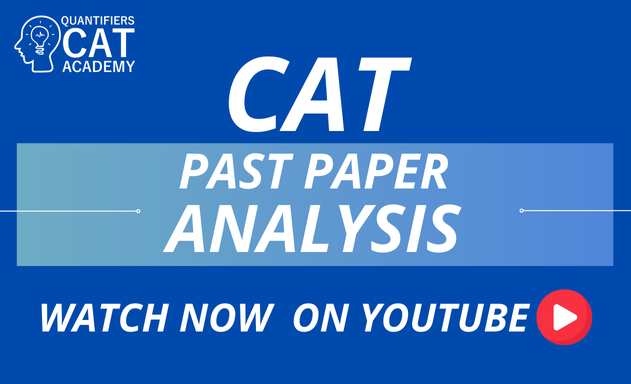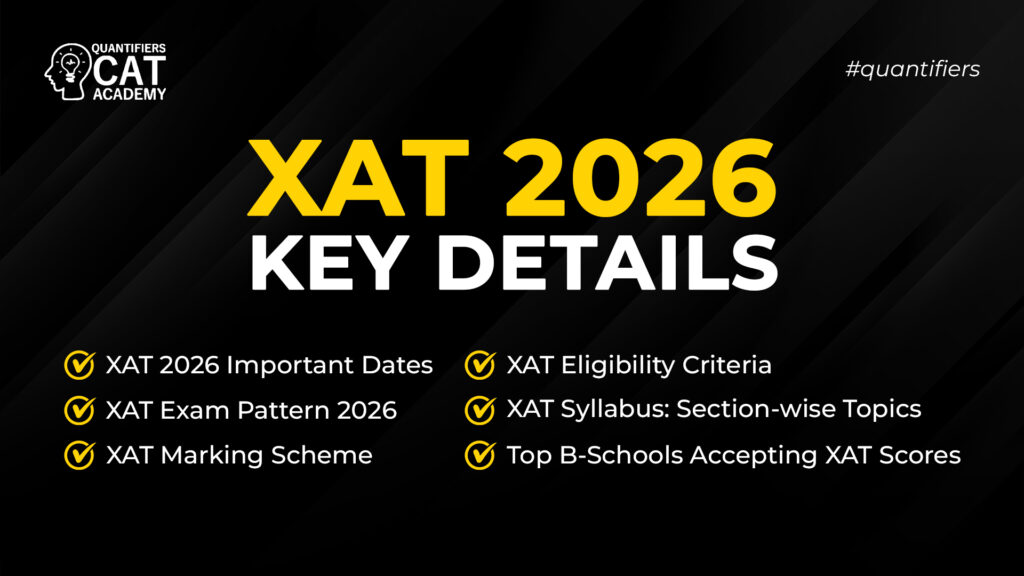
XAT 2026: Everything You Need to Know
Table of Contents
Introduction to XAT Exam
The Xavier Aptitude Test (XAT) is one of India’s most prestigious and competitive national-level management entrance examinations. Conducted by XLRI Jamshedpur on behalf of XAMI (Xavier Association of Management Institutes), XAT has been the gateway to premier MBA/PGDM programs for over 75 years
Key Highlights of XAT 2026
- Accepted by 250+ premier B-Schools across India
- Conducted in 80+ test cities nationwide
- Unique Decision Making section testing practical business acumen
- No age limit for candidates
- No minimum percentage requirement for eligibility
- Registration fee: ₹2,200
- Total duration: 3 hours (180 minutes)
- Total questions: 95 (each carrying 1 mark)
XAT stands out from other management entrance exams due to its distinctive Decision Making section, which evaluates candidates’ ability to apply critical thinking and problem-solving skills to real-world business and personal scenarios
XAT 2026 Important Dates
Candidates must stay updated with the XAT 2026 exam schedule to ensure timely completion of all formalities. Below is the complete timeline for XAT 2026:
| Event | Date |
| Registration Start Date | July 10, 2025 |
| XAT Mock Test Window Opens | July 10, 2025 |
| Registration Last Date | December 05, 2025 |
| Application Edit Window Closes | December 05, 2025 |
| Admit Card Download Begins | December 20, 2025 (Tentative) |
| XAT 2026 Exam Date | January 04, 2026 (Sunday) |
| Exam Timing | 2:00 PM to 5:00 PM (IST) |
| Result Announcement | January 31, 2026 (Expected) |
| Score Card Download Window | Jan 31 – Mar 31, 2026 |
| XLRI Personal Interview Round | March – April 2026 |
Important Note: The registration deadline of December 5, 2025, is strict. Candidates are advised to complete their registration well in advance to avoid last-minute technical issues
XAT Eligibility Criteria
XAT 2026 has straightforward eligibility requirements, making it accessible to a wide range of candidates.
Educational Qualification
- A bachelor’s degree of minimum 3 years duration (or equivalent) is mandatory
- Candidates appearing for final year examinations in June 2026 are also eligible to apply
- The degree should be from a recognized university or institution
- There is no minimum percentage requirement for eligibility
Age Limit
XAT 2026 has no age limit. Candidates of any age group can apply for the examination. This makes XAT accessible to fresh graduates, working professionals, and career changers alike
Nationality Requirements
- Indian nationals can apply through XAT
- NRI, Foreign, OCI, and PIO candidates may apply to management programs through GMAT scores
Number of Attempts
There is no restriction on the number of attempts for XAT. Candidates can appear for the exam multiple times to improve their scores
Reservation Policy
XLRI and most XAT-accepting institutions are private and do not follow government reservation policies. All candidates are evaluated on merit without caste-based reservations. However, some individual institutes accepting XAT scores may have their own reservation norms
XAT Exam Pattern 2026
Understanding the XAT exam pattern is crucial for effective preparation. The exam is divided into two parts with distinct sections.
Overall Structure
| Parameter | Details | Remarks |
| Total Duration | 180 minutes | 3 hours |
| Total Questions | 95 | All objective type |
| Total Marks | 95 | 1 mark per question |
| Exam Mode | Computer-based (CBT) | Online |
| Difficulty Level | Easy to Moderate | Compared to CAT |
Section-wise Distribution
| Section | Questions | Time | Good Attempts |
| Verbal & Logical Ability (VALR) | 26 | 170 min | 14-15 |
| Decision Making (DM) | 21 | 12-13 | |
| Quantitative Aptitude & Data Interpretation (QA & DI) | 28 | 19-20 | |
| General Knowledge (GK) | 20 | 10 min | All 20 |
| Total | 95 | 180 min |
Part 1: Main Sections (170 minutes)
The first part consists of three sections that contribute to your overall percentile. Candidates can move freely between these three sections during the 170-minute window.
1. Verbal & Logical Ability (VALR) – 26 Questions
This section tests language proficiency and reasoning skills through diverse question types.
2. Decision Making (DM) – 21 Questions
This is XAT’s unique and signature section that distinguishes it from other MBA entrance exams. It presents real-life scenarios from both personal and professional contexts, requiring candidates to apply critical thinking and ethical reasoning.
3. Quantitative Aptitude & Data Interpretation (QA & DI) – 28 Questions
This section assesses mathematical and analytical abilities covering fundamental concepts from Class 10-12 mathematics.
Part 2: General Knowledge (10 minutes)
The GK section consists of 20 questions divided into:
- Static GK: 8 questions (history, geography, awards, sports, constitution, science, economy, business, politics, etc.)
- Current Affairs: 12 questions (recent events, business news, government policies from last 6-8 months)
Important: The GK section has a separate 10-minute time limit and does not contribute to the overall percentile calculation. However, it is considered in the selection process for XLRI programs
Time Management
- Part 1 (VALR + DM + QA&DI): 170 minutes with free movement between sections
- Part 2 (GK): Fixed 10 minutes at the end (no movement back to Part 1)
- PwD candidates receive an additional 20 minutes per hour of exam duration
XAT Marking Scheme
Understanding the XAT marking scheme is critical for strategic exam planning and maximizing your score. XAT has a unique marking structure that differs from other management entrance exams.
Marking Structure
| Scenario | Marks | Applicable Sections |
| Correct Answer | +1 mark | All sections |
| Incorrect Answer | -0.25 marks | VALR, DM, QA&DI only |
| First 8 Unattempted Questions | No penalty | VALR, DM, QA&DI only |
| 9th and Beyond Unattempted | -0.10 marks each | VALR, DM, QA&DI only |
| Incorrect Answer in GK | No penalty | GK section only |
| Unattempted in GK | No penalty | GK section only |
Key Marking Insights
Unique Unattempted Question Penalty:
XAT has a distinctive penalty structure for unattempted questions. You can skip up to 8 questions across Part 1 sections without any penalty. However, from the 9th unattempted question onwards, each skipped question attracts a penalty of 0.10 marks
General Knowledge – No Negative Marking:
The GK section has no negative marking for incorrect or unattempted questions. Therefore, candidates should attempt all 20 GK questions
Strategic Implications:
- Attempt questions you’re confident about first
- Use the 8-question buffer wisely for extremely difficult questions
- Be cautious about skipping more than 8 questions in Part 1
- In the GK section, attempt all questions since there’s no negative marking
Focus on accuracy rather than attempting all questions
Example Score Calculation:
If a candidate:
- Answers 68 questions correctly: 68 × 1 = 68 marks
- Answers 12 questions incorrectly: 12 × (-0.25) = -3.0 marks
- Leaves 15 questions unattempted: 8 × 0 + 7 × (-0.10) = -0.7 marks
Total Score = 68 – 3.0 – 0.7 = 64.3 marks
XAT Score vs Percentile (Based on 2025 Data)
| XAT Score | Percentile |
| 38.2 | 99 |
| 33.8 | 97 |
| 29.25 | 92.5 |
| 24.7 | 85 |
| 20 | 80 |
| 16 | 75 |
| 12 | 70 |
| 11 | 65 |
| 10 | 60 |
Note: The score-percentile conversion varies each year based on overall difficulty and candidate performance
XAT Syllabus: Section-wise Topics
The XAT syllabus is comprehensive and tests candidates on aptitude, decision-making abilities, and general awareness.
Verbal & Logical Ability (VALR) – 26 Questions
| Topic Area | Sub-topics |
| Reading Comprehension | Passages from diverse domains, main idea identification, inference, author’s viewpoint, tone analysis, strengthening/weakening arguments |
| Vocabulary | Synonyms, antonyms, fill in the blanks, contextual meaning, word usage |
| Critical Reasoning | Assumptions, conclusions, premises, cause and effect, logical deductions |
| Grammar | Sentence correction, error identification, subject-verb agreement, tenses |
| Para Jumbles | Arranging jumbled sentences in logical order |
| Cloze Test | Fill in the blanks in passages with appropriate words |
| Sentence Completion | Complete sentences or paragraphs logically |
Preparation Focus:
- Read quality newspapers daily (The Hindu, Indian Express, Economic Times)
- Practice diverse RC passages (business, science, social issues, arts)
- Build vocabulary through contextual learning (20-30 words daily)
- Master critical reasoning question types
Decision Making (DM) – 21 Questions
| Topic Area | Sub-topics |
| Analytical Reasoning | Data arrangement, grouping, logical sets, sequencing |
| Ethical Decision Making | Business ethics, moral dilemmas, professional conduct scenarios |
| Situational Decision Making | HR-related situations, business problems, social dilemmas, stakeholder management |
| Logical Analysis | Assumptions, premises, conclusions, cause-effect relationships |
Important Note: The DM section does not have a fixed syllabus. Questions are scenario-based and test practical problem-solving qualities, empathy, and balanced judgment[1][2].
Preparation Approach:
- Practice all previous year XAT Decision Making questions extensively
- Read business case studies and ethical dilemmas
- Develop a structured approach: identify problem → analyze stakeholders → evaluate options → choose balanced solution
- Think from multiple perspectives (employer, employee, society, ethics, business viability)
Quantitative Aptitude & Data Interpretation (QA & DI) – 28 Questions
| Topic Area | Sub-topics |
| Arithmetic | Percentages, profit & loss, simple & compound interest, ratios & proportions, averages, time & work, time speed & distance, mixtures & alligations |
| Algebra | Linear equations, quadratic equations, inequalities, logarithms, progressions (AP, GP) |
| Geometry | Lines, angles, triangles, circles, polygons, coordinate geometry |
| Mensuration | Area, perimeter, volume, surface area of 2D and 3D shapes |
| Modern Mathematics | Permutation & combination, probability, set theory |
| Data Interpretation | Tables, bar graphs, pie charts, line graphs, caselets, data sufficiency |
Preparation Strategy:
- Master Class 10-12 mathematics fundamentals
- Focus on high-weightage topics: Arithmetic (35-40%), Algebra (20-25%), Geometry (15-20%)
- Practice mental calculation and approximation techniques
- Solve DI sets with time constraints
- Learn shortcut methods and formulas
General Knowledge (GK) – 20 Questions
| Category | Coverage |
| Static GK (8 questions) | Indian history, geography, awards & honors, sports, books & authors, important personalities, Indian constitution, science & technology |
| Current Affairs (12 questions) | National & international events (last 6-8 months), business news, economic developments, government policies, summits & conferences, new appointments |
Preparation Tips:
- Read newspapers daily focusing on editorial and business pages
- Follow monthly current affairs compilations (July 2025 – December 2025)
- Revise important awards, summits, appointments, and policy changes
- Make concise notes for quick revision
- Since there’s no negative marking, attempt all 20 questions
XAT Registration Process
The XAT 2026 registration process is entirely online and must be completed before December 5, 2025.
Step-by-Step Registration Guide
- Visit Official Website: Go to xatonline.in
- Create Account: Register with email ID and mobile number
- Email Verification: Verify your registered email ID through confirmation link
- Fill Application Form: Provide accurate personal, academic, and professional details
- Upload Documents:
- Recent passport-size photograph (max 100 KB, JPG/JPEG format)
- Signature image on white paper (max 50 KB)
- Valid ID proof (scanned copy)
- Select Programs: Choose XLRI programs if interested (additional ₹200 per program)
- Payment: Pay registration fee online via credit/debit card, net banking, or UPI
- Submit Form: Review all details carefully and submit the form
- Save Confirmation: Download and save the application confirmation page
Registration Fees
| Category | Fee (INR) |
| XAT Registration Fee | ₹2,200 |
| Additional Fee for Each XLRI Program | ₹200 |
| Indian Candidates via GMAT/GRE for XLRI PGDM(GM) | ₹2,500 |
| NRI/Foreign/PIO/OCI Candidates via GMAT | ₹5,000 |
Document Requirements
- Photograph: Recent color photo (max 100 KB, JPG/JPEG format)
- Signature: Clear signature on white paper (max 50 KB)
- ID Proof: Valid government-issued photo ID (Aadhaar, PAN, Passport, Driving License, Voter ID)
- Academic Certificates: Degree certificate or provisional certificate (for final year students)
Application Edit Window
Candidates can edit their application details until December 5, 2025. After this date, no changes will be allowed
Admit Card Download
- Admit cards will be available from December 20, 2025 (tentative)
- Download from the official XAT website using registration credentials
- Carry a printed copy to the exam center
- Verify all details on admit card match your ID proof
XAT Exam Day Guidelines: Dos and Don’ts
Proper preparation for exam day ensures a smooth testing experience and helps avoid unnecessary stress or disqualification.
Reporting Time and Entry Rules
| Event | Time |
| Exam Center Gates Open | 12:30 PM |
| Reporting Time | 1:00 PM |
| Gates Close (Strict) | 1:30 PM |
| Exam Starts | 2:00 PM Sharp |
| Exam Ends | 5:00 PM |
Critical Warning: Late entries are NOT allowed under any circumstances. If you arrive after 1:30 PM, you will not be permitted to enter
Mandatory Items to Carry
| Item | Details |
| XAT Admit Card | Downloaded from official website (printed copy) |
| Valid Photo ID | Aadhaar, PAN, Passport, Driving License, Voter ID (original) |
| Simple Analog Watch | To track time (smartwatches strictly prohibited) |
| Additional Photo ID (Optional) | Backup identification for safety |
Dress Code Guidelines
- Wear simple, comfortable, light-colored clothing
- Avoid jackets, blazers, or clothes with multiple pockets
- Prefer open-toed footwear (sandals or slippers) for quick security checks
- Avoid excessive jewelry or metallic accessories
- Long sleeves may be subject to additional checking
- No religious symbols or accessories that may cause delay
Strictly Prohibited Items
- Mobile phones and all electronic gadgets
- Calculators, smartwatches, fitness bands
- Books, notes, newspapers, or any study material
- Bags, pencil boxes, pouches, wallets (except small transparent pouch for essentials)
- Food items (except small snack if needed for medical reasons with permission)
- Water bottles (water may be provided at center)
- Jewelry or metallic items (watches with metal straps)
- Bluetooth devices, earphones, headphones
- Any written material or blank paper
- Pens, pencils (rough sheets provided at center)
Exam Day Dos
- Arrive Early: Reach the exam center 45-60 minutes before reporting time (by 12:30-12:45 PM)
- Verify Details: Cross-check that admit card details match your ID proof exactly
- Stay Calm: Practice deep breathing exercises if feeling anxious or stressed
- Follow Instructions: Listen carefully to all announcements and invigilator instructions
- Cooperate with Security: Be patient and cooperative during frisking and document verification
- Read On-Screen Instructions: Go through all on-screen instructions carefully before starting
- Manage Time Wisely: Keep track of time across sections, don’t spend too long on any single question
- Attempt Strategically: Start with your strongest section to build confidence
- Use Rough Sheets Properly: Use provided rough sheets for calculations, don’t tear or remove them
- Stay Hydrated: Drink water before entering the exam hall
- Use Washroom: Visit the washroom before exam starts (washroom breaks during exam may not be allowed)
- Keep Calm Throughout: If you encounter difficult questions, stay composed and move to easier ones
Exam Day Don’ts
- Don’t Be Late: Gates close at 1:30 PM sharp with no exceptions
- Don’t Panic: Stay composed even if initial questions seem difficult
- Don’t Argue: Avoid disputes or arguments with exam center staff or invigilators
- Don’t Carry Prohibited Items: Leave all gadgets, bags, and study materials at home
- Don’t Over-attempt: Quality matters more than quantity; avoid random guessing
- Don’t Get Stuck: If a question takes too long (>3 minutes), mark for review and move on
- Don’t Ignore Instructions: Follow all guidelines strictly to avoid disqualification
- Don’t Use Rough Sheets Improperly: Don’t tear, fold excessively, or try to take them out
- Don’t Look Around: Focus on your own screen; looking at others’ screens may be considered misconduct
- Don’t Rush Unnecessarily: Read questions carefully; hasty reading causes silly mistakes
- Don’t Discuss Exam: Avoid discussing questions during breaks or after exam within center premises
- Don’t Violate Rules: Any rule violation may lead to cancellation of candidature
Health and Safety Guidelines
- Carry personal hand sanitizer if needed (small transparent bottle)
- Maintain appropriate behavior and decorum
- Inform invigilators immediately if feeling unwell
- Follow any COVID-19 or health protocols if applicable
XAT Preparation Strategy
Effective preparation requires a strategic approach combining conceptual clarity, consistent practice, and smart time management.
Create a Structured Study Plan
Phase 1: Assessment (Weeks 1-2)
- Take a diagnostic test to identify strengths and weaknesses
- Analyze performance across all four sections
- Set realistic score targets: Overall target and sectional targets
- Identify weak topics that need more attention
Phase 2: Foundation Building (Months 1-2)
- Study fundamental concepts in each section systematically
- Build strong vocabulary foundation (20-30 words daily)
- Master basic quantitative formulas and shortcuts
- Understand Decision Making approach through previous year analysis
- Start reading newspapers daily for VALR and GK
Phase 3: Practice Phase (Months 3-4)
- Solve topic-wise questions with increasing difficulty
- Take sectional mock tests regularly
- Analyze mistakes thoroughly and maintain error log
- Improve speed through timed practice
- Focus on accuracy before speed
Phase 4: Mock Test Phase (Final 1-2 months)
- Take full-length XAT mock tests regularly (15-20 mocks minimum)
- Simulate exact exam conditions (timing, environment, no breaks)
- Review and analyze each mock test for 2-3 hours
- Identify pattern in mistakes and work on them
- Refine section-wise time allocation strategy
- Track improvement in scores and percentile
Phase 5: Revision Phase (Final 15 Days)
- Take one mock test every 2-3 days
- Revise all formula sheets, shortcuts, and notes
- Focus on current affairs of last 6-8 months for GK
- Review all flagged/difficult questions
- Maintain consistency, avoid learning new topics
- Get adequate sleep (7-8 hours) and stay stress-free
Section-wise Preparation Strategy
Verbal & Logical Ability (VALR):
- Reading Comprehension: Read 2-3 quality articles daily from The Hindu, Indian Express, Economic Times editorial pages. Practice 5-6 RC passages weekly from diverse domains.
- Vocabulary: Learn 20-30 new words daily with contextual usage. Use flashcards and word lists. Focus on usage rather than rote memorization.
- Critical Reasoning: Practice assumption, conclusion, and inference-based questions daily. Master different CR question types.
- Grammar: Revise basic grammar rules. Focus on commonly tested areas like subject-verb agreement, tenses, and sentence correction.
- Para Jumbles: Practice identifying opening and concluding sentences. Look for logical connectors and transition words.
Decision Making (DM):
- Previous Year Papers: Solve all XAT previous year DM questions (2010-2025) multiple times. This is the MOST important resource for DM.
- Case Studies: Read business ethics case studies from Harvard Business Review, management books, and online resources.
- Structured Approach: Develop a consistent framework:
- Read scenario carefully, identify core problem
- List all stakeholders affected
- Evaluate each option’s short-term and long-term impact
- Consider ethical, practical, and business viability aspects
- Choose balanced solution that maximizes overall benefit
- Multiple Perspectives: Practice thinking from different viewpoints (employer, employee, customer, society, shareholders).
- Discussion: Discuss DM questions with peers to understand different reasoning approaches.
Quantitative Aptitude & Data Interpretation (QA & DI):
- Fundamentals First: Master Class 10-12 mathematics concepts thoroughly before attempting advanced problems.
- High-Weightage Topics: Prioritize Arithmetic (35-40% weightage), Algebra (20-25%), and Geometry (15-20%).
- Mental Calculation: Practice mental math daily. Learn Vedic math tricks and approximation techniques.
- Formula Mastery: Create a formula sheet for quick revision. Practice applying formulas in different contexts.
- DI Practice: Solve DI sets with time constraints. Focus on extracting relevant data quickly from complex charts.
- Accuracy Focus: Don’t rush. One correct answer is better than three attempted with two wrong.
General Knowledge (GK):
- Daily Reading: Read newspapers daily focusing on national/international news, business, economy, sports, and awards.
- Current Affairs: Follow monthly current affairs compilations. Focus on last 6-8 months (July-December 2025).
- Static GK: Revise Indian history, geography, constitution, awards, sports, and science from standard GK books.
- Note-Making: Maintain concise notes of important events, appointments, summits, and policy changes.
- No Negative Marking: Since GK has no negative marking, attempt all 20 questions based on best judgment.
Time Management Strategy for Exam
| Section | Time (min) | Good Attempts | Strategy |
| VALR | 50-55 | 14-15 | Start with RC, then CR, vocabulary last |
| Decision Making | 40-45 | 12-13 | Read carefully, don’t rush scenarios |
| QA & DI | 55-60 | 19-20 | Attempt easy questions first, skip very difficult |
| Buffer Time | 10-15 | Review | Revisit marked questions, verify answers |
| General Knowledge | 10 (fixed) | All 20 | Attempt all, no negative marking |
| Total | 180 | 65-68 |
Mock Test Analysis Framework
After each mock test, spend 2-3 hours on detailed analysis:
- Score Analysis: Overall score, sectional scores, percentile, rank
- Attempt Analysis: Total attempted, correct, incorrect, accuracy percentage
- Time Analysis: Time spent per section, per question type
- Topic Analysis: Identify weak topics with recurring mistakes
- Error Categorization:
- Silly mistakes (reading error, calculation error)
- Conceptual gaps (didn’t know concept)
- Application errors (knew concept but applied wrongly)
- Time management issues (rushed, spent too long)
- Action Plan: Specific steps to improve identified weaknesses
Common Mistakes to Avoid
- Neglecting the Decision Making section preparation
- Over-attempting without focusing on accuracy
- Ignoring the penalty for unattempted questions (after 8)
- Not taking sufficient full-length mock tests (minimum 15-20)
- Spending excessive time on very difficult questions
- Weak time management across sections
- Ignoring General Knowledge preparation
- Not analyzing mock tests thoroughly
- Learning new topics in last 15 days
- Not practicing previous year papers extensively
- Studying in isolation without peer discussion for DM
- Attempting questions randomly in the last few minutes
Top B-Schools Accepting XAT Scores
XAT scores are accepted by 250+ premier business schools across India, making it one of the most valuable MBA entrance exams after CAT
XAMI Member Institutes (Using XAT as Primary Exam)
| Institute | Location | Programs |
| XLRI Jamshedpur | Jamshedpur, Jharkhand | PGDM (BM), PGDM (HRM) |
| XLRI Delhi-NCR | Delhi-NCR | Executive Programs |
| XIM University Bhubaneswar | Bhubaneswar, Odisha | MBA (BM), MBA (HRM), MBA (SM) |
| XISS Ranchi | Ranchi, Jharkhand | MBA (Rural Management, CSR, HR) |
Other Premier B-Schools Accepting XAT (2026)
- SP Jain Institute of Management & Research (SPJIMR), Mumbai – Note: SPJIMR accepts XAT scores only for select programs like PGPGM (Global Management Program). For regular PGDM programs, CAT and GMAT are preferred[6].
- IMT Ghaziabad, Nagpur, Hyderabad
- Great Lakes Institute of Management, Chennai, Gurgaon
- MICA (Mudra Institute of Communications), Ahmedabad
- Goa Institute of Management (GIM)
- KJ Somaiya Institute of Management, Mumbai
- IRMA (Institute of Rural Management), Anand
- Welingkar Institute of Management, Mumbai
- BIMTECH (Birla Institute of Management Technology), Greater Noida
- Alliance University, Bangalore
- IFMR GSB at KREA University
- Woxsen University
- Rajagiri Business School
- KIIT School of Management, Bhubaneswar
- International School of Business & Media (ISB&M), Pune
- Balaji Institute of Modern Management (BIMM), Pune
Important Note: While SP Jain historically accepted XAT, as of 2024-2025, SPJIMR has limited XAT acceptance primarily to specific programs. For PGDM admissions, CAT and GMAT scores are the primary criteria
Selection Process at Top B-Schools
Most XAT-accepting institutes follow a comprehensive multi-stage selection process:
- XAT Score Screening: Candidates must meet minimum overall and sectional percentile cutoffs
- Academic Profile Evaluation: Performance in 10th, 12th, and graduation is considered
- Work Experience: Relevant work experience adds value (varies by institute)
- Written Ability Test (WAT): Essay writing on business/social topics
- Group Discussion (GD): Group discussion on current affairs or case studies
- Personal Interview (PI): One-on-one interview assessing personality, goals, and fit
- Final Selection: Composite score based on all parameters
Expected Cutoffs for Top Colleges
Understanding cutoff trends helps set realistic targets and choose colleges strategically.
XLRI Jamshedpur Cutoffs (2025 Reference)
Business Management Program:
| Stream | Gender | Overall | QA | VALR | DM |
| Engineer/Tech | Male | ≥96 | ≥88 | ≥84 | ≥84 |
| Engineer/Tech | Female | ≥91 | ≥82 | ≥80 | ≥80 |
| Non-Engineer | Male | ≥96 | ≥88 | ≥84 | ≥84 |
| Non-Engineer | Female | ≥91 | ≥82 | ≥80 | ≥80 |
Human Resource Management Program:
| Stream | Gender | Overall | QA | VALR | DM |
| Engineer/Tech | Male | ≥95 | ≥83 | ≥90 | ≥87 |
| Engineer/Tech | Female | ≥90 | ≥73 | ≥85 | ≥80 |
| Non-Engineer | Male | ≥93 | ≥76 | ≥90 | ≥87 |
| Non-Engineer | Female | ≥87 | ≥68 | ≥85 | ≥80 |
Other Top B-Schools Expected Percentiles (2026)
| Institute | Expected Percentile | Approx. Fees (Lakhs) |
| XLRI Jamshedpur (BM) | 95-96+ | 27-33 |
| XLRI Jamshedpur (HRM) | 93-95+ | 27-33 |
| XIM University, Bhubaneswar | 91+ | 20-22 |
| SPJIMR Mumbai (select programs) | 90-95 | 22 |
| IMT Ghaziabad | 90+ | 19-20 |
| Great Lakes Chennai | 85-90 | 17-18 |
| MICA Ahmedabad | 85-90 | 16-17 |
| GIM Goa | 80-85 | 16 |
| IRMA Anand | 83+ | 16 |
| KJ Somaiya | 70-75 | 21-22 |
| Welingkar Mumbai | 75+ | 14 |
| BIMTECH Greater Noida | 75+ | 14 |
Note: Cutoffs vary each year based on exam difficulty, number of applicants, and seat availability. The above are indicative ranges
Frequently Asked Questions (FAQs)
Q1. What is the full form of XAT?
XAT stands for Xavier Aptitude Test. It is conducted by XLRI Jamshedpur on behalf of XAMI (Xavier Association of Management Institutes)[1].
Q2. Is there an age limit for XAT 2026?
No, XAT 2026 has no age limit. Candidates of any age can apply for the examination[1][2].
Q3. How many times can I attempt XAT?
There is no restriction on the number of attempts. You can take XAT multiple times to improve your score[1][2].
Q4. What is the minimum educational qualification required for XAT?
A bachelor’s degree of minimum 3 years duration (or equivalent) from a recognized university is required. Final year students are also eligible to apply[1][2].
Q5. Is there any minimum percentage requirement for XAT eligibility?
No, there is no minimum percentage requirement in graduation to be eligible for XAT 2026[2].
Q6. Is there any reservation policy in XAT?
No, XLRI and most XAT-accepting institutes are private institutions and do not follow caste-based reservation policies. All candidates are evaluated purely on merit[2].
Q7. How many questions are there in XAT 2026?
There are 95 questions in total: 26 in VALR, 21 in Decision Making, 28 in QA & DI, and 20 in General Knowledge[1][2].
Q8. What is the duration of the XAT exam?
The total duration is 180 minutes (3 hours). Part 1 (VALR, DM, QA & DI) has 170 minutes, and Part 2 (GK) has a separate 10-minute window[1][2].
Q9. Is there sectional time limit in XAT?
No, there is no sectional time limit for Part 1 sections (VALR, DM, QA & DI). You can move freely between these three sections during the 170-minute window. Only the GK section has a fixed 10-minute time limit at the end[1][2].
Q10. What makes XAT different from other MBA entrance exams?
XAT’s unique Decision Making section distinguishes it from exams like CAT, GMAT, and MAT. This section tests practical problem-solving and ethical reasoning in real-world business and personal scenarios[1][2].
Q11. Does the GK section affect my percentile?
No, the GK section does not contribute to the overall percentile calculation. However, it is considered separately in the selection process for XLRI programs[1][2].
Q12. Can I move between sections in XAT?
Yes, you can move freely between VALR, DM, and QA & DI sections during the 170-minute Part 1 window. However, once Part 2 (GK) begins, you cannot go back to Part 1 sections[2].
Q13. What is the marking scheme for XAT 2026?
Each correct answer gives +1 mark. Each incorrect answer deducts -0.25 marks. You can skip up to 8 questions without penalty. From the 9th unattempted question onwards, -0.10 marks are deducted per question. GK section has no negative marking[1][3][4].
Q14. Is there negative marking in the GK section?
No, the GK section has no negative marking for incorrect or unattempted questions. Therefore, attempt all 20 GK questions[1][3].
Q15. What happens if I leave more than 8 questions unattempted?
You can skip up to 8 questions across Part 1 sections without any penalty. However, from the 9th unattempted question onwards, you will lose 0.10 marks per unattempted question[1][3][4].
Q16. Should I attempt all questions in XAT?
No, focus on accuracy over quantity. Given the negative marking and unattempted penalty, it’s better to attempt questions you’re confident about. However, in the GK section, attempt all questions since there’s no negative marking[3].
Q17. What is a good score in XAT?
A score of 35-40+ (out of 95) is considered very good and can fetch calls from top institutes. For XLRI, a raw score of 38+ with strong sectional performance is typically required for 99 percentile[3].
Q18. What is the last date to register for XAT 2026?
The last date to register for XAT 2026 is December 5, 2025[1][2].
Q19. What is the registration fee for XAT 2026?
The registration fee is ₹2,200. An additional ₹200 is charged for each XLRI program you apply to[1][2].
Q20. Can I edit my application after submission?
Yes, you can edit your application until December 5, 2025, through the application edit window[1][2].
Q21. When will XAT 2026 admit cards be available?
Admit cards are expected to be available for download from December 20, 2025 (tentative)[1][2].
Q22. What documents are required for XAT registration?
You need a recent passport-size photograph, signature image, valid government-issued photo ID, and academic certificates (degree or provisional certificate for final year students)[2].
Q23. What should I carry to the XAT exam center?
You must carry your XAT admit card (printed copy) and a valid original photo ID proof (Aadhaar, PAN, Passport, Driving License, or Voter ID)[1].
Q24. Can I carry a calculator to the exam?
No, calculators are strictly prohibited. All calculations must be done mentally or using the rough sheets provided at the exam center[1].
Q25. What is the reporting time for XAT 2026?
The reporting time is 1:00 PM, and gates close at 1:30 PM sharp. The exam starts at 2:00 PM. Late entries are not allowed[1][2].
Q26. What items are prohibited in the exam center?
Mobile phones, electronic gadgets, calculators, smartwatches, books, notes, bags, jewelry, food items, and any written material are strictly prohibited[1].
Q27. What is the dress code for XAT exam?
Wear simple, comfortable, light-colored clothing. Avoid jackets, clothes with multiple pockets, and excessive jewelry. Open-toed footwear is recommended for easier security checks[1].
Q28. How should I prepare for the Decision Making section?
Practice extensively with previous year XAT papers (this is the MOST important resource), read business ethics cases, and develop a balanced approach considering both ethics and practicality. There’s no fixed syllabus for this section[1][2].
Q29. Is XAT easier than CAT?
Generally, XAT is considered slightly easier than CAT in terms of difficulty level. However, the Decision Making section can be challenging as it requires a different skill set focused on practical judgment[2].
Q30. How many mock tests should I take before XAT?
Aim for at least 15-20 full-length mock tests, starting 2-3 months before the exam. Gradually increase the frequency as the exam approaches. Spend 2-3 hours analyzing each mock[3].
Q31. What are the best books for XAT preparation?
For VALR: Word Power Made Easy (Norman Lewis), previous year papers. For QA: Standard CAT preparation books. For DM: Previous year XAT papers are the best resource. For GK: Monthly current affairs compilations and newspapers[3].
Q32. How much time should I allocate to each section?
Recommended: VALR (50-55 min), DM (40-45 min), QA & DI (55-60 min), Buffer (10-15 min), GK (10 min fixed)[3].
Q33. When will XAT 2026 results be announced?
XAT 2026 results are expected around January 31, 2026[2][3].
Q34. How is the XAT percentile calculated?
The percentile is calculated based on your performance relative to all test-takers. Only Part 1 sections (VALR, DM, QA & DI) contribute to the percentile calculation. GK is evaluated separately[1][2].
Q35. What percentile is required for XLRI admission?
For XLRI Jamshedpur, typically a 95-96+ percentile is required for the Business Management program and 93-95+ for the Human Resource Management program. Strong sectional percentiles are also mandatory[3].
Q36. Does SPJIMR accept XAT scores?
As of 2024-2026, SPJIMR accepts XAT scores only for select programs like PGPGM (Global Management Program). For regular PGDM programs, CAT and GMAT are the primary accepted exams[6].
Q37. How many colleges accept XAT scores?
Over 250+ MBA/PGDM colleges across India accept XAT scores for admission[1][5].
Q38. Do work experience and academics matter for admission?
Yes, most XAT-accepting institutes consider your entire profile including 10th, 12th, graduation marks, work experience, and performance in WAT, GD, and PI rounds for final selection[5].
Q39. Can I apply to multiple colleges with one XAT score?
Yes, you can apply to multiple XAT-accepting colleges with your XAT score. While registering for XAT, you can select XLRI programs, and separately apply to other institutes[1][2].
Q40. What is the validity of XAT score? XAT score is typically valid only for the current admission cycle (2026-27 for XAT 2026). You cannot use an old XAT score for future admissions
Conclusion
XAT 2026 offers an excellent opportunity for MBA aspirants to gain admission to 250+ premier business schools across India. With its unique Decision Making section and comprehensive assessment approach, XAT identifies candidates who possess not just academic excellence but also practical wisdom, ethical judgment, and business acumen.
Key Takeaways for XAT 2026 Success
- Register Early: Complete registration well before December 5, 2025 deadline
- Understand Pattern: Master the exam pattern, marking scheme, and time management
- Balanced Preparation: Focus on all four sections including Decision Making and GK
- Practice Extensively: Take minimum 15-20 full-length mock tests
- Analyze Thoroughly: Spend 2-3 hours analyzing each mock test
- Previous Year Papers: Solve XAT papers from 2010-2025, especially for Decision Making
- Stay Updated: Read newspapers daily for VALR and GK sections
- Strategic Attempting: Use the 8-question buffer wisely, focus on accuracy
- Exam Day Discipline: Follow all guidelines, arrive early, stay calm
- Set Realistic Targets: Aim for 65-68 good attempts with 90%+ accuracy
Final Advice
Success in XAT requires dedicated preparation, strategic planning, consistent effort, and smart exam-taking skills. The unique Decision Making section rewards candidates who think holistically, balance ethics with pragmatism, and demonstrate mature judgment.
Start your preparation early, practice extensively with previous year papers, take regular mock tests, and maintain consistency throughout your preparation journey. Remember that XAT tests not just your knowledge but your ability to make sound decisions under pressure—a skill that will serve you well throughout your management career.Stay focused, stay confident, and approach XAT 2026 strategically. Best of luck!



















